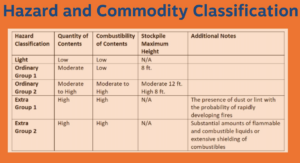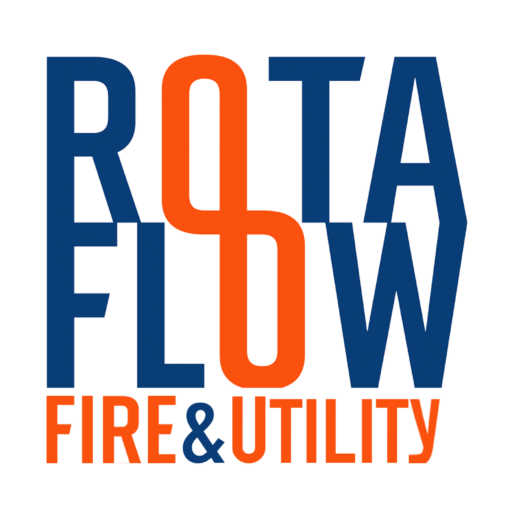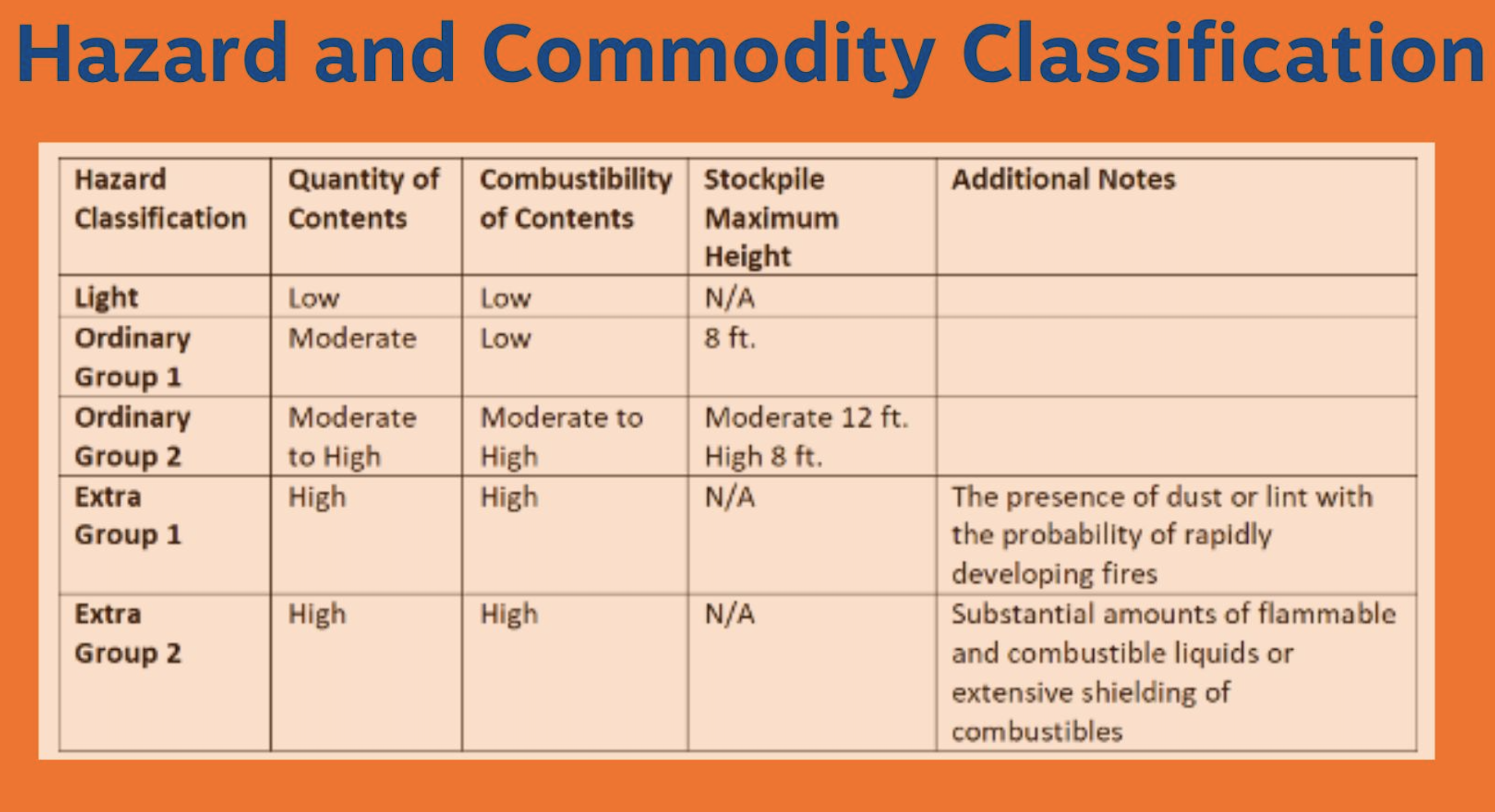INTRODUCTION:
The Discharge Criteria Committee is responsible for classifying fire risks, establishing discharge standards, planning and calculating sprinkler systems, and managing water supply. Data from the EOD programme shows that the majority of requests for interpretation are related to hazard classification and commodity classification. It is the responsibility of an engineer to determine both hazard and commodity classification and set goals and design standards. The most important details in this text are the rules for danger classification and general requirements of NFPA 13, 2022 edition. Hazard classification is seen as the most crucial element of fire prevention system design and is a duty of the responsible design expert in many states.
Chapter 4 of NFPA 13, 2022 edition contains the rules for danger classification as well as general requirements. Miscellaneous storage, low pile storage, miscellaneous tyre storage, light hazard, ordinary hazard, additional hazard, high pile storage or specific occupancy risks are among the several categories of dangers. Annex A for the sections on hazard classification contains information and explanations. The NFPA 13 standard for specific occupancies is based on the materials’ quantity and combustibility. High-piled storage is defined as storage arrangements with Class I through Class IV commodities stored at a height of more than 12 feet or Group A polymers stored at a height of more than 5 feet that do not meet the standards of miscellaneous storage, low-piled storage or miscellaneous tire storage.
pecial occupancy dangers are defined in Chapter 27, and the general standards for storage are provided in Chapter 20. Testing results from a reputable testing organization can be used to determine the proper categorization of a commodity. Class I, Class II, Class III, Class IV, cartooned no expanded plastic, cartooned expanded plastic, exposed nonexpanded plastic, and exposed expanded plastic are some of the commodity classifications. Pallets that were used to transport the cargo must also be taken into account. Noncombustible goods are classified as Class I commodities if they are directly placed on wood pallets, packaged in solid wood boxes, multiple-layered corrugated cartons, slatted wooden crates, or other comparable combustible packaging. Products manufactured from wood, paper, natural fibres, or Group C polymers are Class III commodities. The NFPA 13 Discharge Committee’s Class IV commodities include Group B plastics, free-flowing Group A plastics, products that are cartoned, or within a wooden container, with greater than 5 percent and up to 15 percent by weight of Group A non-expanded plastic or greater than 5 percent and up to 25 percent by volume of expanded Group A plastics. Rubber, plastics, and elastomers are classified as Group A, Group B, or Group C materials, and Annex A for the commodity classification sections contains information and explanations. Mixed commodity storage must be safeguarded in accordance with the standards for the highest commodity categorization, and there is an exception that allows up to 10 randomly distributed pallet loads of a higher hazard commodity to be safeguarded based on the lower commodity classification in a space not larger than 40,000 ft2.
DISCHARGE RULES
Over 1,200 informal interpretations submitted by NFSA members are processed annually. This is accomplished through the Expert of the Day (EOD) programme, in which participants enquire about fire sprinkler-related laws, regulations, and standards from the top industry experts.
The Discharge Criteria Committee is one of the NFPA 13 committees. This group is in charge of classifying fire risks, establishing relevant discharge standards, planning and calculating sprinkler systems, and managing water supply. Definitions, general requirements, water sources, design strategies, the protection of storage, special occupancies, and plans and calculations are all included in this.
According to data gathered from the EOD programme, the majority of requests for interpretation in relation to the duties of the discharge committee are related to hazard classification and commodity classification. This shows that these subjects have a lot of interest and are frequently the most important and difficult NFPA 13 topics to address.
To that end, the NFSA and our partner organizations concur that it is the responsibility of an engineer to determine both the hazard and commodity classification. Engineer and the Engineering Technician Designing Fire Protection Systems has further information on this position.
Setting the goals and design standards is the engineer’s responsibility. This comprises categorizing the risk(s), storage arrangements, goods that need to be protected, and design requirements.
Therefore, the following is included in EOD responses to queries about danger and commodity classification: Except in cases where an NFPA committee has specifically addressed the topic, questions about danger or commodity classification are challenging. This is particularly true given that the classification is seen as the most crucial element of fire prevention system design and a duty of the responsible design expert in many states. Involving a competent design professional is necessary in many states, among other reasons, to make sure that the project’s site-specific characteristics are acknowledged and properly addressed, which cannot be done in a generic manner.
HAZARD CLASSIFICATION
Chapter 4 of NFPA 13, 2022 edition, contains the rules for danger classification as well as general requirements. Fuel load determines the level of hazard, not just the use or occupancy of the facility. It is crucial to remember that the occupancy categories offered in the standard serve just to help identify the danger classification and the sprinkler design. Based on the typical anticipated fuel load for that kind of occupancy, they were created. When determining the hazard categorization, unusual or atypical fuel loading or flammable properties should be taken into account.
Miscellaneous storage, low pile storage, miscellaneous tyre storage, light hazard, ordinary hazard, additional hazard, high pile storage or specific occupancy risks are among the several categories of dangers.
Miscellaneous storage is defined as storage that is less than 1,000 square feet in size, does not exceed a height of 12 feet, occupies less than 10% of the building’s floor space or 4,000 square feet of the sprinklered area, and is separated from other storage piles or areas by at least 25 feet.
Class I through Class IV commodities must be stored in piles no higher than 12 feet, while Group A polymers must be stored in piles no higher than 5 feet.
The term “miscellaneous tyre storage” refers to piles of tyres stored on tread that are no more than 2,000 square feet and no taller than 25 feet in the direction of the wheel holes.
The accompanying safety standards for low-piled and unrelated tire storage are detailed in Chapter 4.
Based on the quantity and combustibility of the materials as well as stockpile height, light, ordinary, and extra hazards are classified. This information is summarized in the table below.

While not a part of the standard’s requirements, Annex A for the sections on hazard classification contains information and explanations. There are occupancies examples for each category of risk. As stated above, please exercise caution as the materials’ quantity and combustibility are what determine the hazard categorization. For instance, the annexe includes educational (school) occupancies as a light hazard. The standard would, however, classify a number of areas in a school as being conventional hazards, including labs, machine shops, commercial kitchens, and parking lots.
High-piled storage is defined as storage arrangements with Class I through Class IV commodities stored at a height of more than 12 feet or Group A polymers stored at a height of more than 5 feet that do not meet the standards of miscellaneous storage, low-piled storage or miscellaneous tire storage. The product classification and protection standards for high-piled storage are left up to the storage chapters (20–26).
In Chapter 27, special occupancy dangers are defined. 34 specifically identified special occupancies are included. In many instances, the NFPA 13 standard for specific occupancies will refer to another NFPA standard. For instance, NFPA 45 is mentioned in Section 27.10 for laboratories handling chemicals. The relevant danger classification is provided in NFPA 45, Chapter 6.
COMMODITY CLASSIFICATION
The general standards for storage, which include those for commodity classification, are provided in Chapter 20. The types and quantities of materials used to make up a product and its packaging are the basis for commodity classification. This covers not only the item being stored, but also the pallets and packing supplies as well. In many situations, determining the proper categorization can be challenging, and testing may be required to accurately characterize the commodity. When particular test results from a reputable testing organization are available, the results may be used to determine the categorization of the commodity.
Class I, Class II, Class III, Class IV, cartooned no expanded plastic, cartooned expanded plastic, exposed nonexpanded plastic, and exposed expanded plastic are a few of the commodity classifications. Group A, B, or C further categorize plastic goods.
When defining the commodity classification, pallets that were used to transport the cargo must also be taken into account. Several requirements related to the type of pallet utilized and the adjustment necessary to establish the correct product classification are provided in Section 20.3.2. For instance, Class I through Class IV goods using unreinforced high-density polyethylene or polypropylene plastic pallets must have their classification raised by one class.
Noncombustible goods are classified as Class I commodities if they are directly placed on wood pallets, contained in single-layer corrugated cartons, shrink-wrapped, or paper-wrapped as a unit load.
Noncombustible goods packaged in solid wood boxes, multiple-layered corrugated cartons, slatted wooden crates, or other comparable combustible packaging are referred to as Class II commodities.
Products manufactured from wood, paper, natural fibres, or Group C polymers are referred to as Class III commodities. They are allowed to have 5% or less of nonexpanded plastic by weight or 5% or less of expanded Group A or Group B polymers by volume.
Class IV commodities include:
- Group B plastics
- Free-flowing Group A plastics
- Products that are cartooned, or within a wooden container, with greater than 5 percent and up to 15 percent by weight of Group A non-expanded plastic or greater than 5 percent and up to 25 percent by volume of expanded Group A plastics
- A mix of Group A expanded and non-expanded plastics that complies with Figure 20.4.3.3(a)
- Exposed, with greater than 5 percent and up to 15 percent by weight of Group A non-expanded plastic
- Exposed, with a mix of Group A expanded and non-expanded plastics and complies with Figure 20.4.3.3(b).
Rubber, plastics, and elastomers are classified as Group A, Group B, or Group C materials, and the standard’s body lists several instances of each. Expanded, exposed, and cartoned plastics are all defined in Chapter 3. Rubber tyres, rolled paper, baled cotton, and cartoned records are other specialized commodity classes.
Again, while not a part of the standard’s criteria, Annex A for the commodity classification sections contain information and explanations. There are provided examples for each commodity classification. The annexe information warns users that many storage arrays do not precisely fall into one of the primary classifications in real-world storage settings; as a result, the user must compare each classification to the actual storage conditions before making any decisions. The annexe also lists a number of particular commodities that the standard does not cover.
A variety of goods is fairly prevalent. Here, mixed commodity storage must be safeguarded in accordance with the standards for the highest commodity categorization. There is an exception that allows up to 10 randomly distributed pallet loads of a higher hazard commodity to be safeguarded based on the lower commodity classification in a space that is not larger than 40,000 ft2, provided there are no contiguous loads in any direction (including diagonally). The standard includes clauses that permit mixed commodities to be separated.
This TechNotes is a brief overview of the two most frequent inquiries about the NFPA 13 Discharge Committee sent to the NFSA’s EOD programme. The NFSA will keep responding to EOD inquiries from our members and use this knowledge to enhance the rules and standards. The EOD service benefits members directly and advances the fire sprinkler sector as a whole.
Courtesy: This edition of TechNotes was written by Michael Joanis, P.E., Chief Engineer for NFSA.



